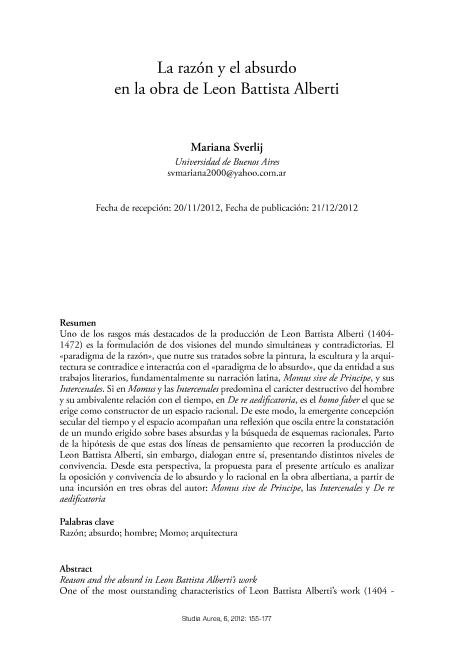Mostrar el registro sencillo del ítem
dc.contributor.author
Sverlij, Mariana

dc.date.available
2023-06-05T13:20:45Z
dc.date.issued
2012-12
dc.identifier.citation
Sverlij, Mariana; La razón y el absurdo en la obra de Leon Battista Alberti; Universidad Autónoma de Barcelona; Studia Aurea; 6; 12-2012; 155-177
dc.identifier.issn
1988-1088
dc.identifier.uri
http://hdl.handle.net/11336/199542
dc.description.abstract
Uno de los rasgos más destacados de la producción de Leon Battista Alberti (1404- 1472) es la formulación de dos visiones del mundo simultáneas y contradictorias. El "paradigma de la razón", que nutre sus tratados sobre la pintura, la escultura y la arquitectura se contradice e interactúa con el "paradigma de lo absurdo", que da entidad a sus trabajos literarios, fundamentalmente su narración latina, Momus sive de Principe, y sus Intercenales. Si en Momus y las Intercenales predomina el carácter destructivo del hombre y su ambivalente relación con el tiempo, en De re aedificatoria, es el homo faber el que se erige como constructor de un espacio racional. De este modo, la emergente concepción secular del tiempo y el espacio acompañan una reflexión que oscila entre la constatación de un mundo erigido sobre bases absurdas y la búsqueda de esquemas racionales. Parto de la hipótesis de que estas dos líneas de pensamiento que recorren la producción de Leon Battista Alberti, sin embargo, dialogan entre sí, presentando distintos niveles de convivencia. Desde esta perspectiva, la propuesta para el presente artículo es analizar la oposición y convivencia de lo absurdo y lo racional en la obra albertiana, a partir de una incursión en tres obras del autor: Momus sive de Principe, las Intercenales y De re aedificatoria.
dc.description.abstract
One of the most outstanding characteristics of Leon Battista Alberti’s work (1404 -1472) is the formulation of two simultaneous and contradictory visions of the world. The «paradigm of the reason» that nourishes his treatises on painting, sculpture and architecture contradicts and interacts with the «paradigm of the absurd», that encourages his literary works, particularly his Latin narrative Momus sive de Principe and his Intercenales. If in Momus and Intercenales there is a predominance of the destructive character of men and his ambivalent relationship with time, in De re aedificatoria, it is the homo faber the one that is erected as creator of a rational space. Thus the emerging secular conception of time and space goes together with a reflection that alternates between the verification of a world constructed over an absurd basis and the search for rational frameworks. My hypothesis is that these two trains of thought that can be found throughout Leon Battista Alberti’s work are in constant conversation, showing different levels of rapport. From that perspective, this paper intends to analyze the opposition and coexistence of the absurd and the rational in Alberti’s work, by examining his Momus sive de Principe, the Intercenales and De re aedificatoria.
dc.format
application/pdf
dc.language.iso
spa
dc.publisher
Universidad Autónoma de Barcelona
dc.rights
info:eu-repo/semantics/openAccess
dc.rights.uri
https://creativecommons.org/licenses/by-nc-sa/2.5/ar/
dc.subject
RAZÓN
dc.subject
ABSURDO
dc.subject
MOMO
dc.subject
ARQUITECTURA
dc.subject.classification
Literaturas Específicas

dc.subject.classification
Lengua y Literatura

dc.subject.classification
HUMANIDADES

dc.title
La razón y el absurdo en la obra de Leon Battista Alberti
dc.title
Reason and the absurd in Leon Battista Alberti’s work
dc.type
info:eu-repo/semantics/article
dc.type
info:ar-repo/semantics/artículo
dc.type
info:eu-repo/semantics/publishedVersion
dc.date.updated
2023-06-02T11:05:25Z
dc.journal.number
6
dc.journal.pagination
155-177
dc.journal.pais
España

dc.journal.ciudad
Barcelona
dc.description.fil
Fil: Sverlij, Mariana. Consejo Nacional de Investigaciones Científicas y Técnicas; Argentina. Universidad de Buenos Aires; Argentina
dc.journal.title
Studia Aurea
dc.relation.alternativeid
info:eu-repo/semantics/altIdentifier/url/https://dialnet.unirioja.es/servlet/articulo?codigo=4846560
Archivos asociados
